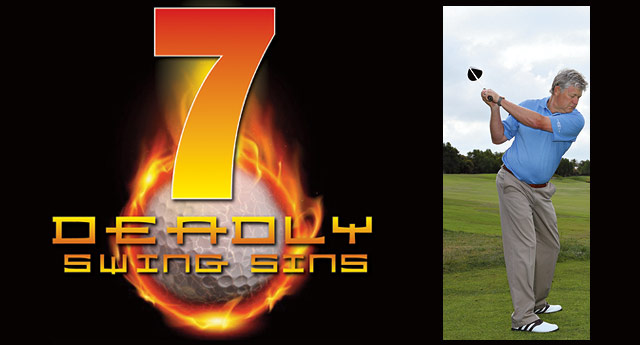
When it comes to making critical swing flaws that wreak havoc on your ability to score, there are a handful of swing sins that you must avoid. The consequences of the following mistakes usually result in hellish results, so pay attention to the quick fixes I've outlined for each swing flaw. Lucky for you, no matter how deadly these swing sins may be, the quick fix is easy to accomplish. Read on, confess, and say goodbye to making the same swing mistakes.
SLICED DRIVES A slice occurs usually because your clubface is open and you probably have an outside-to-in swingpath into the ball, thus creating slice spin. Odds are, you're getting your arms and club too far behind your shoulders on the backswing, too. When this happens, you get too much forearm roll on the backswing, your clubface opens, and often your head drifts too far back. To recover, you have to use the upper body instead of the lower body to start the forwardswing, and you end up throwing your hands and club outside the target line on your downswing. Yuck! The goal is the opposite. You want a swing with a driver that's more inside-to-out, not outside-to-in.

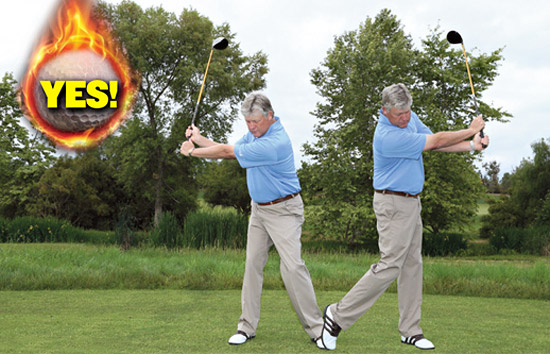
FIX #1 Take a stance with both feet flared open. Make a three-quarter practice swing with a split grip, and swing L to reverse L, keeping both your arms and elbows in front of your shoulders. Then, put your hands together, set up to the ball, and hit it with the same feel. The split-grip drill will improve your path and create a nice release to square up the face.
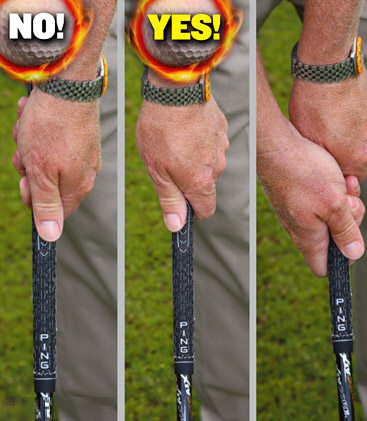
FIX #2 The second reason most people slice their driver is because the face is open at impact due to a weak grip that no doubt promotes an open face at impact. To strengthen your grip, get your left thumb aimed right of the clubhead so you see at least two knuckles. We don't want the left thumb pointing down at the clubface. Now, place your right hand on the grip so that lifeline fits right against the left thumb. It will feel different if we changed your grip, but this should help square up the clubface much more effectively.
CHUNKED IRON SHOTS Most fat shots occur because your weight has stayed on the back foot instead of moving toward your front foot. The key is to not try to help the ball up, but let the club's loft do its job for you! You want to get to your left side in the downswing and focus on the bottom of your swing arc being past the ball on all iron shots. In other words, the bottom of the swing arc is under your left shoulder, not the ball, folks.
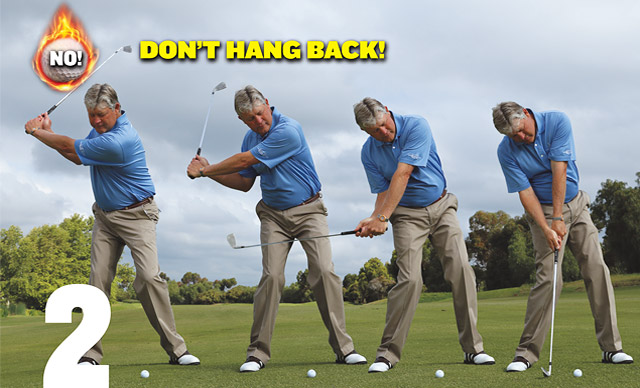
THE FIX The first step is to understand that impact position is different than setup position. At impact, you're dynamic: You're getting into your left side, the hips are turning open, there's forward shaft lean, and the clubface is squaring up. The most important factor, again, is knowing that the bottom of the swing arc is under the left shoulder. Meaning, you should be hitting slightly down instead of trying to help the ball up. You want cut the grass and take a divot past your ball, not before it.
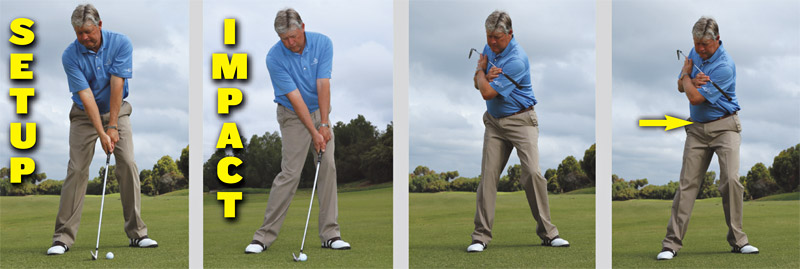
Also, you need to understand what it means to shift to your left side. Set up with the club across the shoulders and make a backswing. To start the downswing, feel as though you shift into the ball, with the left shoulder staying lower than the right. When you swing, just shift to the left, let the arms drop, and then you can rotate to your target. Don't lean back to help the ball up! It may feel like you're sliding left at first, but as long as you continue with a solid "bump" and rotation through the downswing, it's not a slide. It's how the downswing should look and feel!
FLUBBED PITCHES It seems I see the same mistakes with pitch shots over and over again. Maybe it's because a pitch shot is a "tweener" shot, meaning it's not quite a full swing and it's not a short swing like a chip. So, invariably, most golfers mess up by taking a huge backswing and try to finesse the ball with their hands. Talk about a deadly combo! To hit a pitch successfully, go with your normal setup and just play ball in middle of your stance. Remember, the loft of the club gets the ball up in the air; you don't need to help it up with the hands. Second, as you swing, hit down on the ball and allow the hands to extend through the shot. Don't get handsy! Note in the correct photo below the separation of the hands and body after making contact. That's what you want. And it's easy to do as long as you take a more modest backswing and you rotate the body through the shot, not flip the hands through it.
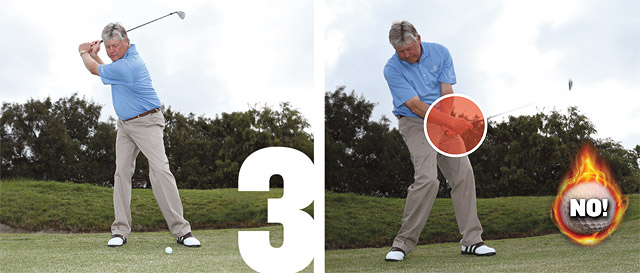
THE FIX
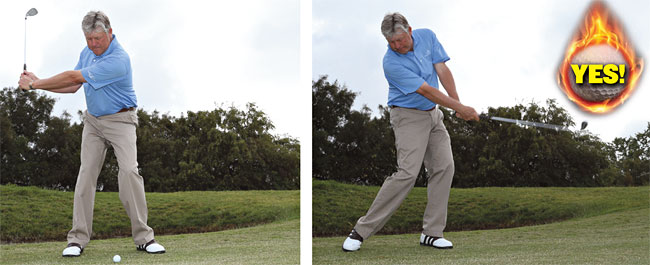
Set up in normal position with the ball in the middle of your stance or favor the weight on the left side with the hands slightly forward. This setup promotes a downward path into the ball. When you take your normal setup in this short swing, you have to create some hinge to flatten out the left wrist in the backswing and rotate the hips open at impact, which increases your speed, thus hitting the ball farther than anticipated with little effort.
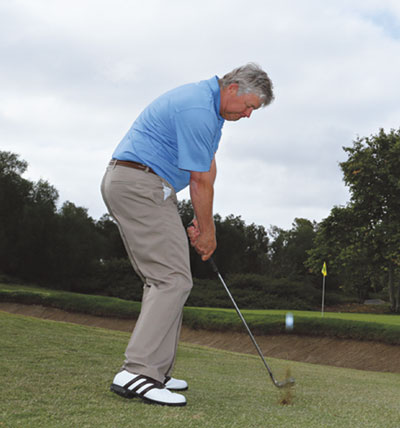
I also want your backswing to be smaller than your followthrough so that you accelerate into the ball to create consistent impact with spin. Simply swing to a 1, 2, 3 count: 1) Turn back; 2) Add a little hinge and start the forwardswing, and by the time you finish counting; 3) You've already hit the ball and cut the grass in front of the ball. You'll want to follow through with the arms, clubshaft, chest, hips and right knee facing the target. This helps eliminate the flip and promotes acceleration in the impact zone.
EPIC BUNKER FAILS If you don't like greenside bunkers and you're trying to help the ball get up over the bunker lip, here's a fix for you. The first step is to simplify your bunker setup and eliminate being too open in your stance or having the clubface too open. I want you to use your normal pitch shot except you'll use the bounce in your clubhead and swing like your ball is in greenside deep rough.
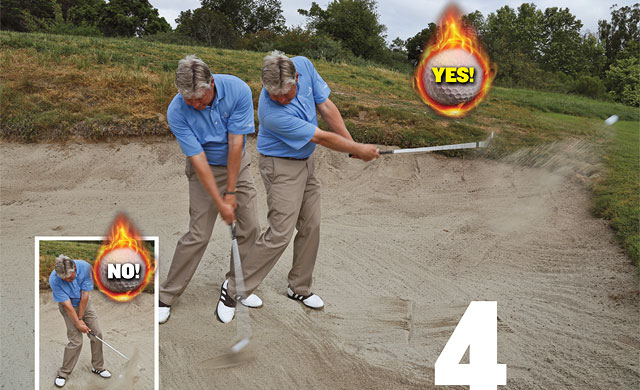
FIX #1
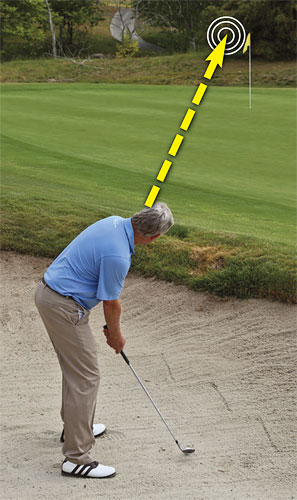
Set up so you're aiming directly at the target and open the face so the bottom scoring lines aim at your left ankle to create a little bounce. Work your feet into the sand a half-inch so you have a shallow divot in the sand. Line up at your target and swing the club at your target to throw the sand on the green and forget about the open face! If you open your body and the clubface too much, you'll tend to swing the club back too far to the inside, creating a lot of problems. Instead, keep your focus on hitting a spot of sand two inches behind the ball and swing down and through. Too often, I see players open up their body too much to the left and open the face too much to the right, which makes the shot much more difficult. Instead, hit a "heavy pitch" and swing aggressively right at the target!
FIX #2 Change your distance thought; if you have a 15-yard bunker shot, you need a 45-yard swing. Yes, multiply the distance you need to hit by three to offset the cushion of sand between the clubface and ball. If you're playing in a firm or wet bunker, double the distance; if you're in soft powder sand, multiply the distance by four. Learn to make a practice swing outside the bunker before you walk into the bunker, so on most 20-yard bunker shots, make a 60-yard practice swing, then walk into the bunker, take your setup and go with the same feel.
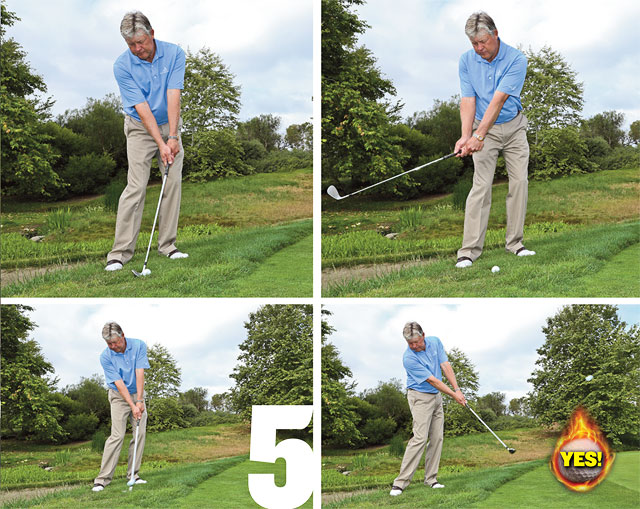
WILD CHIPS Let's face it, folks, there's really no excuse for bad chipping. It's one of the easiest strokes to learn and should be one of the easiest to repeat. Again, like the pitch shots, often I see mistakes made because golfers feel they need to lift the ball up into the air with their hands. In reality, better chippers tend to keep the ball lower to the ground and have more roll with their chips.
THE FIX
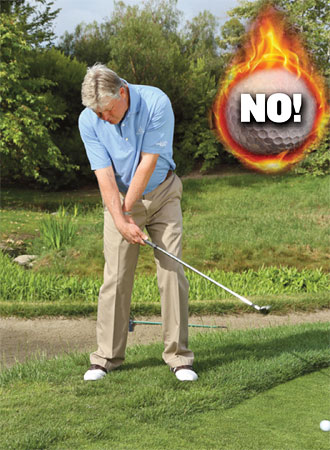
Unique to chipping, go ahead and set up into a posed impact position. This means setting up with the left foot back and the hips open, and your weight is on the left side. The shaft should be in line with the left arm and the clubface pointing at the target. From there, swing the club back and through with minimal wrist hinge. If you take your normal setup in this short swing, you have to create some hinge to flatten out the left wrist and increase your rotation speed to get the hips open at impact, which increases your speed, thus hitting the ball farther than we need for a short bump-and-run shot. Also, once you set up with the desired impact position, simply swing the club and try to keep the "Y" look as the wrists stay fairly quiet. Focus on your finish position, with the hands extended out, hips open and right heel off the ground. You want the ball to release and roll . 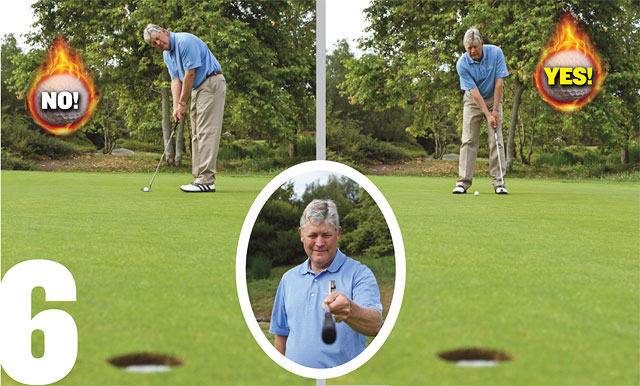
AGGRAVATING 3-PUTTS In order to eliminate 3-putts, you have to focus on your speed control. If you misread the putt by two feet and you have the speed correct, you can walk away with a two-foot putt, but most 3-putts occur because you were seven feet long or six feet short. To improve your speed control on the course, you need to learn how to use your eyes better and incorporate more feel into the stroke.
FIX #1
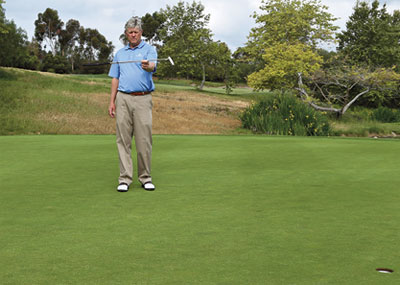
Make your practice strokes one foot behind the ball with your body facing the target. Your eyes are at the target and you want to feel the putterhead in your practice stroke. This allows your eyes and brain to match up the feel of the putterhead and coordinate the desired amount of energy needed for that putt. If your eyes are on the putter or on the ball, your mind is more into your stroke instead of feel and distance control. The reason you're not parallel to the target line in the practice stroke is that if you're right eye-dominant, you have to turn your head and shoulders to see the target, which affects your putting stroke, and this creates confusion in your mind and stroke.
FIX #2 Make your practice strokes one foot behind the ball with your body facing the target. Your eyes are at the target and you want to feel the putterhead in your practice stroke. This allows your eyes and brain to match up the feel of the putterhead and coordinate the desired amount of energy needed for that putt. If your eyes are on the putter or on the ball, your mind is more into your stroke instead of feel and distance control. The reason you're not parallel to the target line in the practice stroke is that if you're right eye-dominant, you have to turn your head and shoulders to see the target, which affects your putting stroke, and this creates confusion in your mind and stroke.
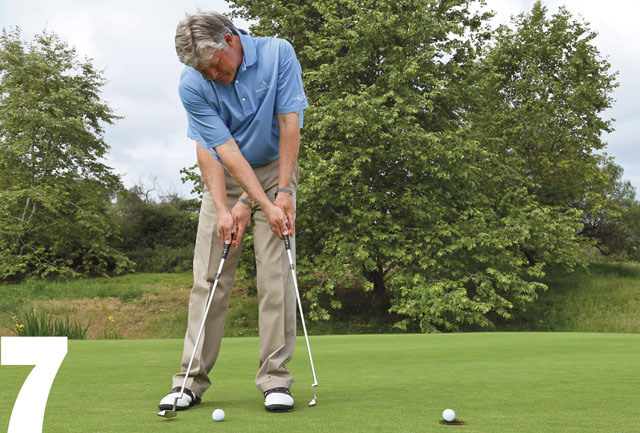
CHOKED SHORT PUTTS In order to make more short putts, you have to focus on the putterface. Odds are, you miss most short putts because the putterface simply isn't aimed at your target when it impacts the ball. So let's find a few ways to make more short putts.
FIX #1 Don't set up your body first and aim the putter last. Learn to aim the putter first, the upper body second and the feet last. The ball only cares about where the face is aimed upon impact and how much energy is applied to the ball. If your putterface is misaligned, the ball always will start offline, and this greatly decreases the odds of making short putts.
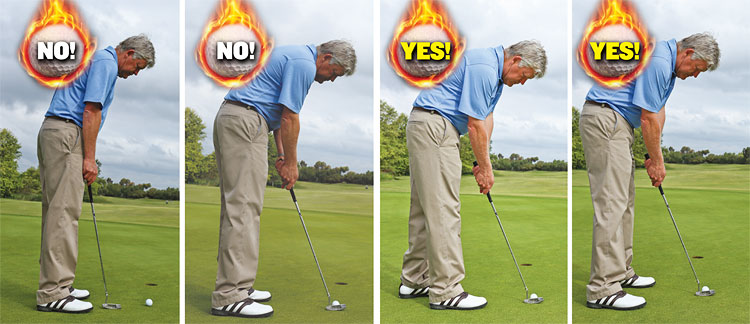
FIX #2 Accelerate the putterface into the ball. If you decelerate the putter into the ball, the clubface alignments usually change. I like to get my students to hit their putts with a one-two beat. Say "one" as you start the backswing and "two" at impact. This will force you to accelerate the putter more effectively and prevent a nasty, yippy stroke into the golf ball.
Top-25 Instructor Glenn Deck, PGA, teaches at the Pelican Hill Golf Academy in Newport Beach, Calif. For information, visit pelicanhill.com.
Angels Ticket for the Upcoming Home Games
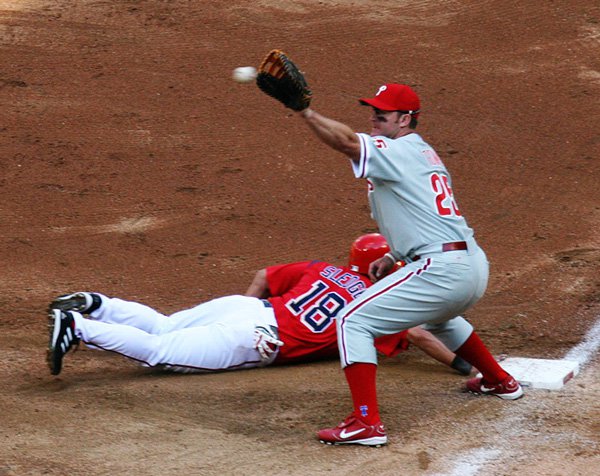
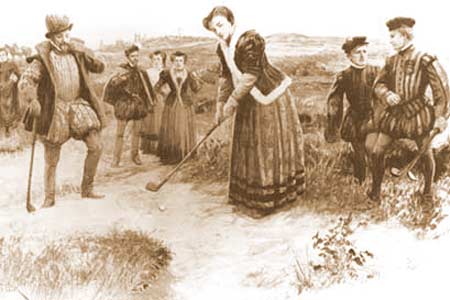
Why Hockey Players Are Great Fly Anglers
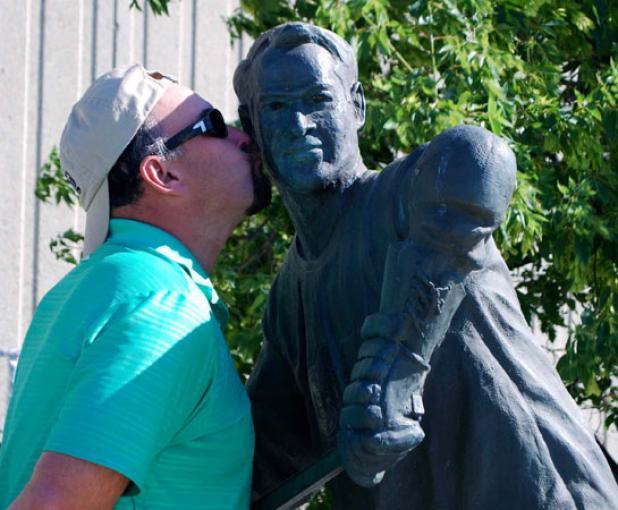
Copyright © www.mycheapnfljerseys.com Outdoor sports All Rights Reserved